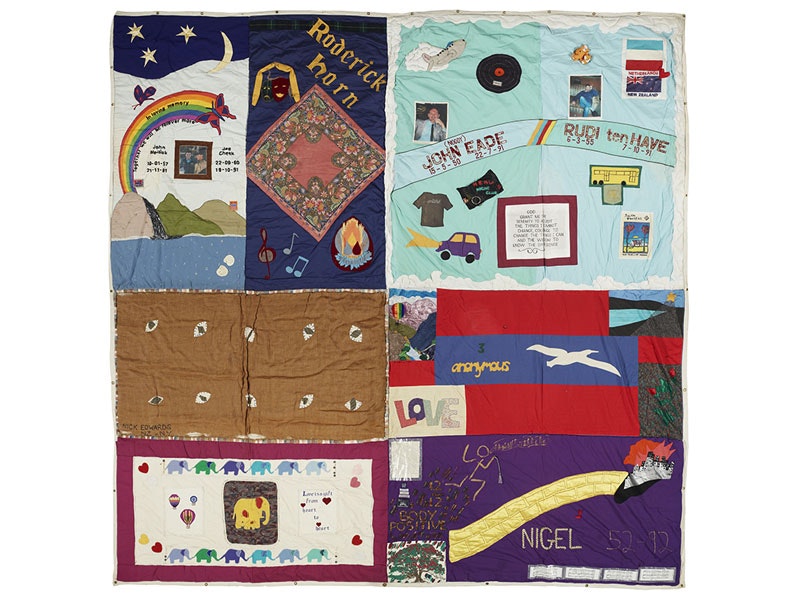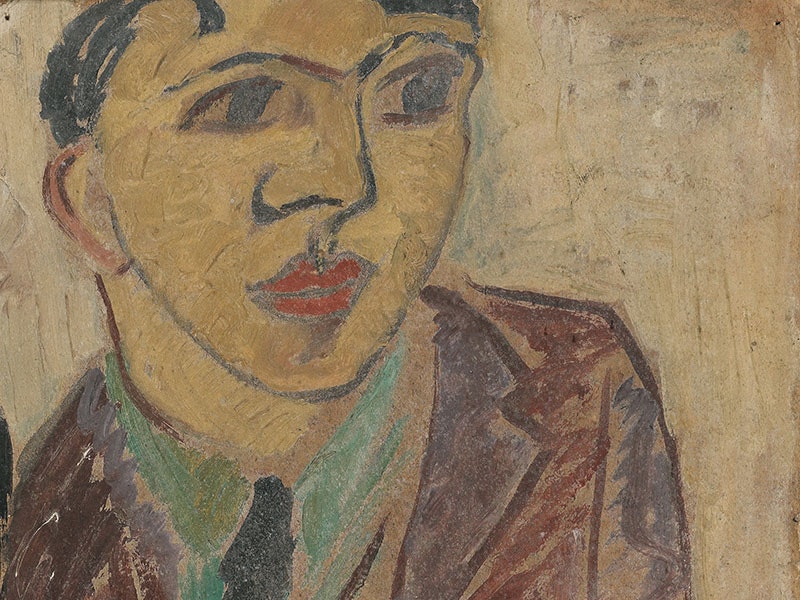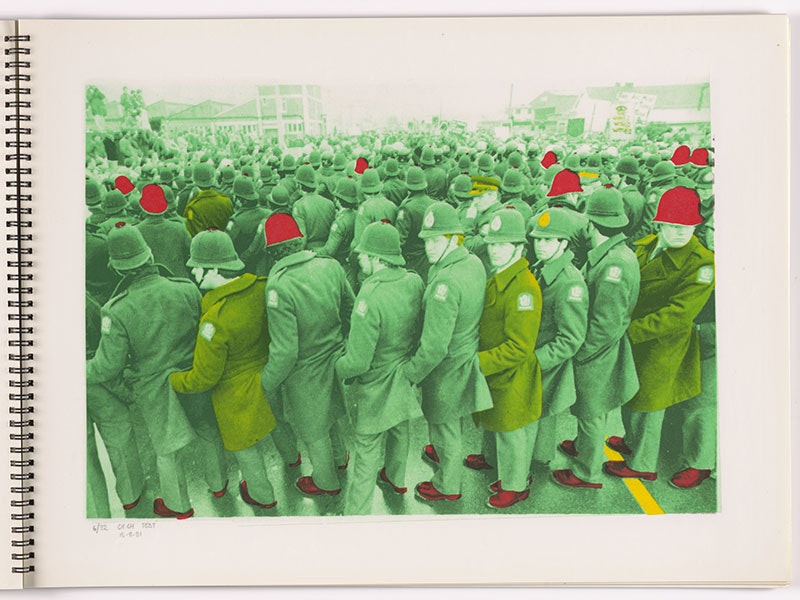I grew up in Pukeatua, which is a little farming district in backwater Waikato. I did the quilt a couple of years ago now, and it’s about the first time I fell in love with anyone. I was nineteen.
I was working up in Northland and I still felt quite lonely as a gay man.
One weekend I came down to Auckland and went to a gay bar and saw Ian over by the bar. He was looking very uncomfortable too. I looked down and on his pants he had cow shit from where he had been wearing gumboots. That seemed like a really good sign so I finally got up the courage and went over and asked him was he having any trouble with milk fever? He laughed because it was not a standard pick-up line in a bar. While everyone was talking about investments and interiors, we were talking about grass staggers and eczema and footrot. I felt for the first time that I had met a man who was gay and also like me.
He was share milking on a farm in the Waikato and it felt really nice to be out there feeding out and moving break fences. It felt comfortable. One morning I woke because I heard the magpies calling. From the window you could see the hills with ti-tree growing on them. He brought in a cup of tea and I had to hide the fact that I was crying. Some things had fitted together and I was scared because I thought I might love him.
It was in the spring when we met and the first panel on the quilt is of the hills outside the bedroom with the spring light on them and the white skies that you get here in the springtime and the ti-tree growing up the side. It’s the hill that’s in the big picture in the centre, the hill that appeared in the four corners. Views from a bedroom seem to be quite significant things.
He drank heaps of coffee and hated tea, really hated it. So I painted his face in coffee. It sounds a bit bizarre, but it actually stains really well. And the writing at the top and bottom are in coffee too. The coffee wouldn’t make the calico go hard. It would always keep it soft. So his face is always soft when you touch it, but the sky and land are hard, they crinkle and crack, but he won’t forever.
He used to have a thing about me being perfect all the time, which meant being a perfect gay and a perfect farmer and a perfect everything. Bugger me down when I was painting the thing, the coffee I was working with bled over the perfect sky. There’s coffee stains under there. I slapped another coat of painting over, but the coffee kept working its way through. So I thought, Welby, just leave it, just leave it.
I put bailing twine all around the picture. When I was making the quilt I went home and got some from my parents. This was my first relationship and Mum and Dad had a lot of trouble coming to terms with me being gay. I was a bit of a loud mouth, that didn’t help things, and I was really angry with them for not accepting my sexuality. I thought, ‘Well, shit, if you loved me then you would understand that I was gay’. Ian said to me, ‘it has taken you nineteen years to come to terms with being gay, why should they come to terms with it over night?’ Which really pissed me off, because of course he was right.
It was quite a dark time for me, because I really loved my family and it had caused this rift. I told him it’s like someone has just turned out the lights on this part of your life. So he gave me this poem about it.
In the light of the day the first you can see is the sun
But in the night when it’s dark you can see the stars
And they are millions of miles further away
And that’s as good as an arm around your shoulder. I put it on the panel because it comforted me at the time and I thought people looking at the quilts, they’re going to need comfort too. It was like an indirect gift from him.
So I painted the view from our bedroom window, and sewed on pieces of his farm clothes. His corduroy pants and his shirts, and a bit off the sofa. They are not flash or shiny, just his work clothes, and brushed cotton because he wore pyjamas.
Nobody I knew wore pyjamas, I’d given them up when I was about twelve. Waking up in the night it was like cuddling up to some kind of kid’s toy, soft and warm.
The brushed cotton on there is black because there is an old New Zealand custom that when somebody died, you sent a letter edged in black. All around that is our towrope off the tractor. The letter edges in black is about grieving but our towrope symbolises other things. We were really practical, ‘sensible shoes’ guys. The towrope is what holds us together, what pulls you out of trouble. Keeps things strong. It’s reliable and that’s what our relationship was and what he was like and that is echoed in the quilt.
He iti he iti kahikatoa is a saying from Maori. It talks about a tree. The same tree painting on the hills – ti-tree or Manuka. It’s only a scrubby little tree, but it always grows back when you’ve cleared the land and burnt it off. It’s little and strong and that’s what he was like. Where my strength was kind of stroppy and confrontational, his was much deeper. So that’s why there is a bit of staunch towrope around the outside. I was worried that it might be a bit of a hassle when it was sewn in with the other quilts, but someone had carefully stitched it so there’s no problem with it.
After we had been together for a while, I got a scholarship to go overseas to study and I really wanted to go. I’d never been out of the country and suddenly this exotic thing, this chance to go to Europe and, I thought, be famous. Ian didn’t want to go, he didn’t want to leave. So I said, ‘I’ll go over and when I come back we will just pick up’. I was pretty innocent then. I thought life waited for you.
The last two pictures from our window are about stars of Pisces rising and Virgo rising seen over the hills and they are both in winter. One is the winter when I left and that has the Pole Star from the Northern hemisphere, because that’s where I went. I went back over to where he had lived and was really surprised that you couldn’t see the stars because of the lights from the city. I knew that the Pole Star was there, so I looked it up in a book to see how to paint it. It was really significant to me that he was born a Virgo and I was a Pisces and we were directly opposite. My fascination with polarities I guess. The other panel has got the Southern Cross on it. His panel has Virgo rising and the hill is on winter too.
When I left, he gave me this poem. It was March and I had my birthday. I was waiting for a big fat present and he gave me this envelope. I opened it up and it was this poem – one he had told me once, about the stars. It was by Yeats and it was very beautiful. It’s called ‘Aedh Wishes for the Cloths of Heaven’, and it’s about our dreams, risks, and probably in a broader view about not being afraid of loving.
Had I the heaven’s embroidered cloths,
Enwrought with the golden and silver light,
The blue and the dim and the dark cloths
Of night and light and the half light.
I would spread the cloths under your feet:
But I, being poor, have only my dreams;
I have spread my dreams under your feet:
Tread softly because you tread on my dreams.
It’s got a bit tattered now on the quilt, I guess with time and travelling but the essence of it is still there.
I still keep that poem in my studio. It’s a poem that helped me understand a parallel between our life and the ethos of what The Quilt is about. About very deep and private things laid out like dreams at other people’s feet. This quilt is a stronger political thing than I’ve ever done, because it is from inside the heart. Not just from the intellect.
When I came back to New Zealand I had had enough of Europe. I didn’t want to live on subways. I didn’t want to spend my time with so many people. New Zealand was suddenly the most wonderful place. It was great to be back. When I got back home, I took my sleeping bag outside and slept out for the first night under the stars, but Ian wanted to go home to England. We wrote to each other and you know how life goes. Things change. It’s always been a hard lesson for me to learn. I sometimes wonder if you come off a farm, then you tend to think things are going to be there forever.
He wrote and told me he was HIV-positive and I just said ‘Oh, not this’. So I wrote and said ‘I’m coming over.’ He said, ‘Don’t come over, I’ll send my spirit back’.
I found out six months after he’d died. I hadn’t had some ‘road to Damascus’ ray of light that came down and said ‘Hey Welby, I’m dead’. I had a lot of trouble coping with that. I’d heard about the Quilt and I thought, maybe if I do a quilt, that’s gonna work. Get the grieving process done with a needle and thread. I can’t even sew a button on. But I could paint. Ian had always been very proud of my painting and had really encouraged me with it. So I tried to do the best painting that I could of him. On calico, which is a real bastard to paint on. I painted his face so it would be soft and the land would be hard (so eventually it would crack), because when I went back down to where we’d worked, again I’d expected things to be the same. And they weren’t. The house had been turned into a hay barn and was full of hay. Where our radishes had been there was just a paddock. So I came away.
I thought that his spirit would come back to me while I was making the quilt. Somewhere in amongst the grief there must have been some rewards. But it didn’t happen like that at all. I finished the quilt, I took it to them, and they put it into this big display. People walked around it, and I was waiting for him. Waiting for him to come and say, ‘Good man’, and it didn’t happen. It didn’t happen until a lot later when I was driving the ute down in the Waikato. He came back, crunch. He was always late.
I haven’t seen the quilt for a couple of years now. I come back to it and, for me, it’s a document about the first love of my life, and a document to the strength and wisdom of a man whose sexuality was important, but only one aspect of that strength. It’s not a very camp thing, it’s gumboots and towropes – but sometimes, for some gay men, that’s what love is.


